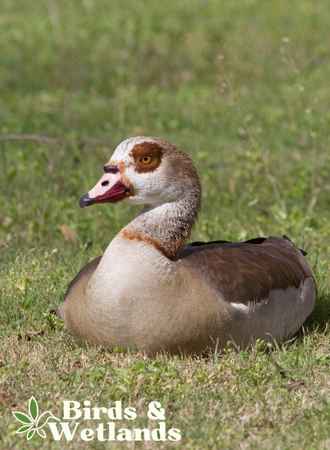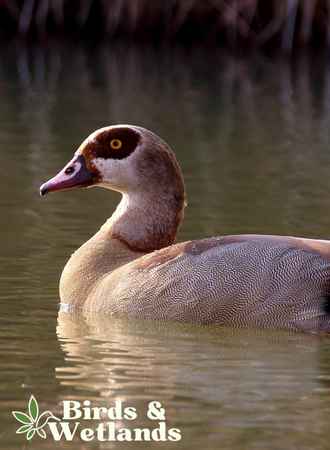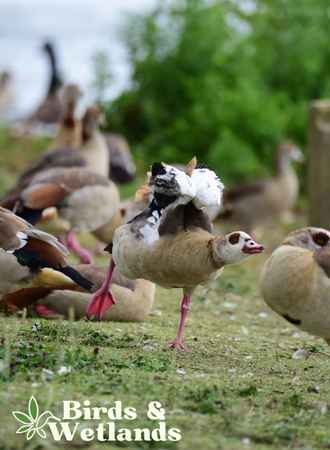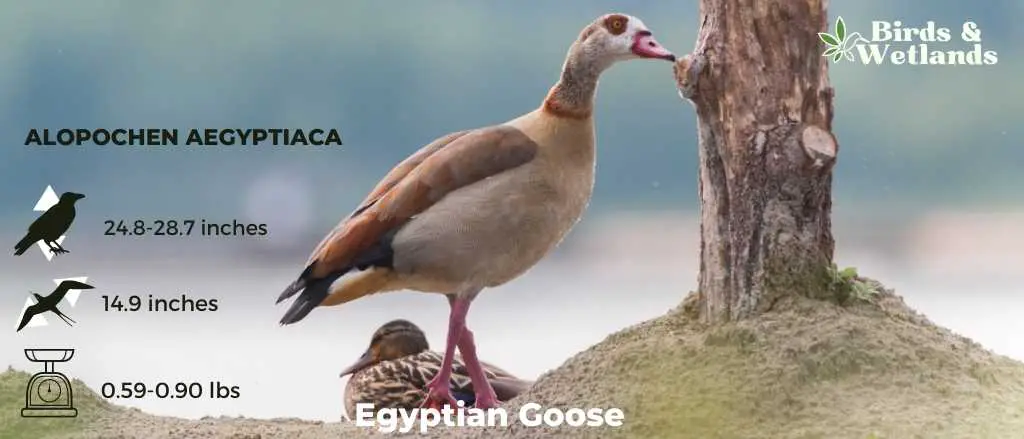The Egyptian goose, or Alopochen aegyptiaca, is a member of the Anatidae family, including ducks and swans. Native to areas located in the Nile Valley and regions to the south of the Sahara Desert, this species is closely related to shelducks.
Historically, ancient Egyptians held the species in high regard and considered it sacred. In fact, depictions of the Egyptian goose frequently appear in hieroglyphics and artwork from ancient times. The species was also admired by the Greeks and Romans, who domesticated it several centuries ago as a source of both food and feathers.
Today, wild Egyptian geese are being hunted extensively in certain parts of Africa.
Scientific Name: Alopochen aegyptiaca
Height: 24.8 to 28.7 cm.
Wingspan: Average 38 cm.
Weight: 1.5 to 2.3 kg.
Egyptian Goose Description
The Egyptian goose is a beautiful and unique bird easily recognizable due to its distinctive markings. The Egyptian goose’s head, neck, breast, and belly are all buffy grey, while a dark patch surrounding the eye gives it a decidedly brooding appearance. Another brown stripe forms a collar around the lower neck and runs towards the nape, creating a distinctive coppery tone.
The yellowish or greyish belly of the Egyptian goose features several dark patches that vary in size, while the undertail coverts are cinnamon-colored. The upper parts of this bird are typically dark brown, with paler brown scapulars and black wings edged in white. The tail of this goose is also black, and its wings are white with metallic green secondaries and black primaries. When in flight, it looks goose-like and heavy.
They have bubble-gum pink legs and bills, while their eyes are typically brown. Both males and females share these characteristics, although the male Egyptian goose tends to be slightly larger than its female counterpart.

Listen to Egyptian Goose
The male makes a loud and wheezy whistle while the female makes a trumpeting quack.
Habitat
The Egyptian goose is a well-adapted species that prefers habitats with warm, wet conditions. The birds prefer open areas with lots of sunlight and lush, grassy vegetation within these habitats. They also thrive in meadows, agricultural fields and grasslands on lowland plains and highland plateaus. They are commonly found in wetlands such as marshes, lakes, ponds, rivers, estuaries and even sewage works, but they can also be found in dryer habitats so long as there is plenty of open water.

Range

The Egyptian goose, or Alopochen aegyptiaca, is a widespread species with a wide range of population estimates. Within Africa, this species can be found breeding in open areas across most of the continent, except in large deserts and dense forests. Its native range includes the Nile Valley and sub-Saharan Africa. They are also year-round residents in other regions where they disperse but do not breed. While not mating, these geese can be found roaming further north into arid regions of the Sahel region.
The Egyptian goose is known to be an invasive species in Europe, having established self-sustaining populations in several European countries and Great Britain. These birds were originally introduced as ornamental specimens for zoos and private collections but have since dispersed throughout much of Europe and become established.
The current Egyptian geese in North America were originally domesticated pets or were part of a zoo collection. Many escapes have occurred over the years, with these individuals eventually growing into feral populations such as those found in Broward County and Palm Beach County near Boynton Beach in Florida.
These populations can be found in states such as Texas, Florida, and California, where they seem to flourish in the warm climates and abundant water supply provided by the region. Despite being non-native species in Florida, they are considered an established species by the Florida Fish and Wildlife Conservation Commission.
Diet
Egyptian geese are primarily herbivores, feeding mostly on seeds, leaves, grass, dead plants, freshwater plankton and plant stems. They also eat worms, locusts and other insects.
Egyptian geese generally tend to be opportunistic eaters, searching out whatever food sources are readily available in their environment.

Nesting & Mating Habits
Breeding season usually begins in the spring or at the end of the dry season.
The mating and breeding habits of Egyptian geese are characterized by aggressiveness and territory protection. During the breeding season, males perform noisy courtship display and maintain strong territoriality, often remaining in isolated pairs outside this period. In addition to this behavior, birds within flocks will also exhibit aggressiveness toward their own species to compete for dominance and resources.
The Egyptian goose typically nests on the ground in sheltered areas, such as among vegetation, on tree ledges, or inside other bird’s abandoned nest cavities at the top of trees. The nest is typically constructed using roots, leaves and grasses lined with down plucked from the female’s breast.
The female then lays between 5 and 11 creamy eggs that she incubates almost entirely on her own over roughly 28 to 30 days. Finally, both parents care for the young chicks after they hatch, feeding them regularly until the fledging phase begins between 8 and 11 weeks later.
Egyptian geese mate for life and travel in flocks.

Population & Conservation
The Egyptian goose is a large species of waterfowl with a wide distribution throughout much of Africa and parts of Europe and Asia. Despite its relatively wide range, the species has experienced some declines in population in recent years. This is mainly due to habitat loss, degradation, and disturbance from humans and other wildlife. However, because its population size remains very high and there are no major threats to this species, the Egyptian goose is currently classified as a species of Least Concern.

Key Points
The Egyptian goose, or Alopochen aegyptiaca, is related to ducks and swans as a member of the Anatidae family.
This species is common across eastern and southern Africa and the Middle East.
Historically, the species was revered and considered sacred by the ancient Egyptians.
The European Union has listed the Egyptian goose as an invasive alien species because they have established self-sustaining populations throughout most of western Europe after being introduced as ornamental specimens for ornamental ponds, zoos & private collections.
The male performs elaborate courtship displays and loud noises. It is also aggressively territorial.


